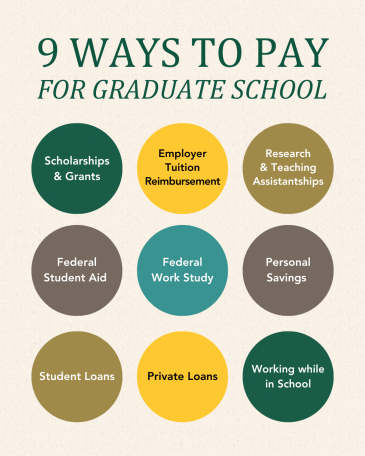
Graduate school is a great next step towards professional success, but funding the degree can be a challenge. Navigating these costs can seem overwhelming, but the good news is that there are numerous options available to ease the financial burden for prospective graduate school students.
If you’re in the process of considering a graduate degree and are concerned about how to fund it, you’re not alone. Many students and professionals face this challenge. Thankfully, there are several strategies you can employ to make graduate school more affordable.
Explore nine practical ways you can use to pay for graduate school, from scholarships and grants to employer tuition assistance and strategic borrowing. By understanding and utilizing these options, you can make your educational aspirations a reality without compromising your financial stability.
The Value of a Graduate Degree
A graduate degree is one of the best ways to advance your career prospects. Not only does it offer you numerous benefits, it can also be a source of personal and professional fulfillment for you.
According to the National Center for Education Statistics, the number of master’s degrees awarded has risen by 19% in the past decade. This reflects a growing demand for and interest in highly skilled workers.
A graduate degree offers numerous benefits including skill enhancement, a competitive edge, higher salary potential, increased promotion opportunity, and valuable networking. Many programs, such as ones at Point Loma Nazarene University (PLNU), also offer flexibility for busy professionals.
Additionally, a graduate degree can facilitate career shifts by providing new skills and professional connections.
9 Ways to Pay for Graduate School
Paying for graduate school can be a daunting challenge, but with the right strategies and resources, it becomes much more manageable. Here are nine effective methods to help you cover the costs of your graduate education.
1. Scholarships & Grants
Scholarships are a type of financial aid that does not need to be repaid and is typically merit-based, awarded for achievements in specific areas. Many schools such as PLNU offer scholarship opportunities for incoming graduate students.
Scholarships are a great way to avoid further student loan debt. As a primary strategy for funding, scholarships can be a great way to keep your student loan debts at a minimum.
To find out which scholarships are available you can begin by contacting the financial department at your prospective school or go on their website to see what scholarships are available. You can also search for scholarships given out by businesses or non-profit organizations.
Scholarships for graduate students may be more difficult to obtain than undergraduate scholarships. As such, it is important that you begin looking and applying for graduate school scholarships early.
2. Employer Tuition Reimbursement
Tuition reimbursement is when an employer repays employees for tuition fees or other education costs after they initially cover the expenses themselves.
Employers may set conditions for reimbursement, such as funding caps, program restrictions, and grade requirements. While this benefit can help with education costs, it requires employees to pay upfront, making it less viable for some students.
However, if you are in a position where you’d be able to pay upfront and are able to meet all the requirements, this could be a great way for you to cover either all of or some of the costs of your tuition.
3. Research and Teaching Assistantships
Another great way to help pay for graduate school is to apply for graduate research and teaching assistantships. Graduate assistantships are vital for graduate education, not only helping you financially but also helping you develop professionally.
These part-time roles in teaching, research or administrative tasks provide tuition fee waivers and stipends, heavily easing the financial burden of graduate school.
Types of graduate assistantships include:
- Teaching assistantships: Involves undergraduate course instruction, lab management, and grading.
- Research assistantships: Supports academic research and lab work.
- Administrative assistantships: Focuses on departmental or university administrative support.
Coupled with other financial payment options, graduate assistantships can greatly aid in you being able to pay your way through graduate school with as little student loan debt as possible. PLNU programs such as the Writing M.A. and Medical Sciences M.S. are expanding the availability of teaching assistant positions that provide full or partial tuition remission.
______
Who are you called to be?
Pursue your purpose at PLNU.
______
4. Federal Student Aid
The Department of Education provides various federal aid options for graduate students including grants, loans and work-study programs.
Federal Grants
Graduate students have limited access to federal grants compared to undergraduates. One of the grants available is the TEACH Grant which offers up to $4,000 per year for students pursuing a teaching career, and requires a four-year service contract-post graduation.
Federal Student Loans
Graduate students can access Direct Unsubsidized Loans, with a yearly limit of up to $20,500 (as of 2024). The aggregate borrowing limit for these loans, including undergraduate amounts, is $138,500. Grad PLUS Loans allow borrowing up to the cost of attendance, minus other financial aid, without requiring financial need, but a credit check is necessary.
Graduate students can use their existing FSA account to submit the FAFSA at StudentAid.gov, but they need to understand the differences in federal financial aid eligibility compared to undergraduates.
To qualify for aid, graduate students must demonstrate financial need, be U.S. citizens or eligible noncitizens, attend an institution with an eligible program, and be enrolled as regular students.
Unlike undergraduates, grad students are considered independent on the FAFSA, meaning they should not include their parents' financial information. This distinction is crucial, as only the student's income and assets are considered for federal aid eligibility.

5. Federal Work-Study
This program enables graduate students with financial need to earn money through part-time jobs related to their field of study, either on or off-campus. Earnings from grad school work study are at least the federal minimum wage and are capped at the maximum award offered for the school year.
6. Personal Savings
Personal savings can be a valuable resource for covering the costs of graduate school. By strategically using savings, you can reduce your reliance on loans and financial aid, minimizing debt burden post-graduation. Savings can be used to pay tuition, purchase textbooks, cover living expenses, and even fund research or study abroad opportunities.
Additionally, having savings can provide a sense of financial security and flexibility, allowing you to focus more on their studies without constant financial worries.
7. Student Loans
There are many student loan options available for graduate students including federal and private.
According to a 2020 report by the Center for American Progress, graduate student loans make up 40% of federal student loans annually. After filing the FAFSA, loans are typically included in the financial aid package along with other forms of aid. Various federal loan options are available for graduate students, including Stafford loans and direct unsubsidized loans, which offer up to $20,500 per year with aggregate limits.
8. Private Loans
Private loans are also an option, although experts recommend starting with federal loans. The U.S. Department of Education's Public Service Loan Forgiveness program (PSLF) provides debt relief for those in public service careers. Before taking on student loan debt, it's crucial for students to research interest rates and understand their repayment options to make informed decisions about financing their education.
9. Working while in school
You can also choose to either work full-time or part-time while pursuing your graduate degree and use those funds to help reduce your financial student load. Many graduate programs take into account the busy schedules and responsibilities that adult students may have and offer flexible hybrid or fully online programs that may allow you to be able to work and pursue your degree at the same time.
PLNU offers many graduate programs specifically designed to accommodate your busy schedule and make it easier for you to continue working while pursuing a graduate degree should you choose to do so.
In addition, PLNU offers attractive financial aid support to help with your graduate financial journey.
Be sure to apply today and contact PLNU’s graduate financial services for additional information.